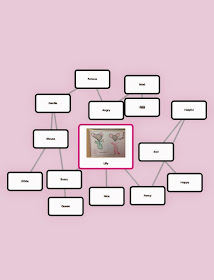I am linking up with Michelle at Fabulous in First Grade for Chapter 5 in the book Worksheets Don't Grow Dendrites by Marcia L. Tate.
This chapter focuses on Graphic Organizers, Semantic Maps and Word Webs. If you read my blog, you know that I use Thinking Maps in my classroom. I was lucky to have worked in a school system that offered training on using Thinking Maps.
These are the different Thinking Maps above.
Although I love Thinking Maps, I also use other kinds of mapping as well. It is important for students to learn different ways to organize their thinking. In the next few years, students in MA will be taking the PARCC exam, and they are expected to use various types of mapping/organizers on this assessment.
This post will share some Thinking Maps and other graphic organizers I use in my classroom.
What the expert say
Having students create a mind or concept map is a meaningful strategy for helping them make sense of and learn vast amounts of new concepts. (Budd, 2004)
MAKING PREDICTIONS
I love the Circle Map for brainstorming. I use this map in all subject areas. I like that student's know immediately that when I draw this Circle Map we are going to brainstorm.
COMPARE AND CONTRAST
 |
| {comparing two people} |
This map is called the Double Bubble.

FLOW MAPS
When graphic organizers are used to change words into images, both left-and right-brain learners can use those images to see the big picture. (Gregory& Parry, 2006)
 |
This Flow map is an example of retelling a story. This chapter gave excellent examples of story retelling maps you can use in the classroom.
TECHNOLOGY
Popplet is a great app that makes maps for you!
GETTING KIDS TO MAKE MAPS
This chapter reminded me that I needed to have kids show their thinking independently. I am going to try to give my students more open-ended response sheets. You can download the one I made below.
Happy Thinking!
Follow Joyful Learning in KC's board Thinking Maps and Venn Diagrams on Pinterest.











I'm consistently in awe of your maps and how you don't use them for the sake of using them, but you use them to increase student learning. Well done!
ReplyDeleteTammy, Thank you for your kind words... it's a huge compliment coming from you! Melissa
ReplyDeleteI love your response sheets for thinking. You are a thinking map master! What a great post. Thanks for linking up.
ReplyDeleteOh my word - this post makes me just wanted to dive in and give these a try. I love how simple the thinking maps are. Now, those I could follow and use!
ReplyDeleteHolly
Crisscross Applesauce in First Grade
Holly, So simple and Pinterest has so many great example too! Happy Sunday. Melissa
ReplyDeleteThanks for the great ideas for my littles in science! I have been teaching 23 years and it is always nice to get new ideas!
ReplyDeleteRenee at The Science School Yard
Renee,
ReplyDeleteI am glad you got a new idea! Melissa